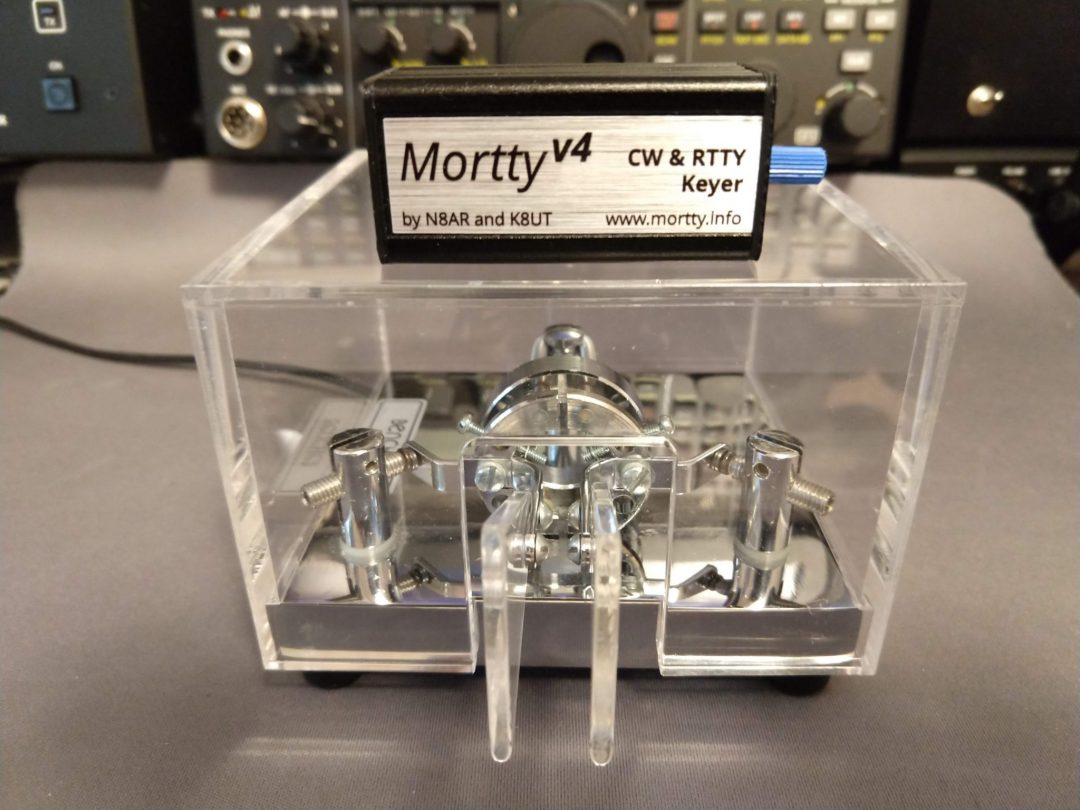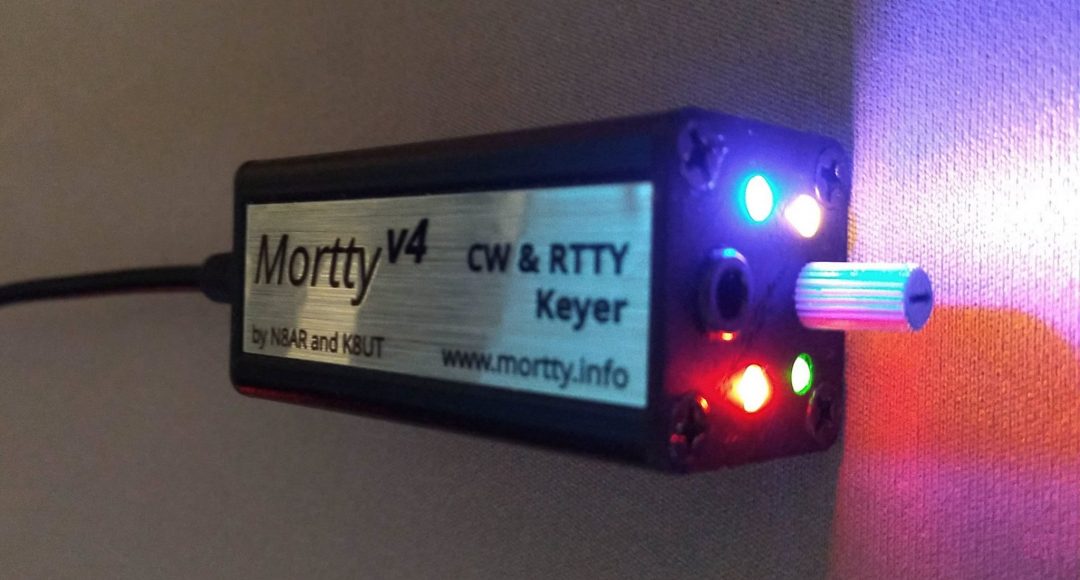
DISCONTINUED – Mortty v4 CW and RTTY Keyer
Looking for Mortty v5? Click here: WWW.MORTTY.NET
Mortty v4 Overview

Morse Code and RTTY Keyer
Morttyv4 is a fully assembled and tested keying solution that provides a miniature enclosure and a computing platform for three freeware keying programs: K0SM’s TinyFSK RTTY Keyer, K3NG’s CW Keyer, or W1HKJ’s nanoIO dual mode program.
Unlike full-featured – and more expensive – hardware solutions for CW and RTTY keying that are widely available to amateurs, Mortty is an inexpensive solution that depends upon the configuration and control features incorporated in popular logging and control programs. This tiny box measures only 2 inches long and 1 inch square (50mm by 25mm). The input end has a USB mini-B jack to connect a computer and a 3.5mm TRRS jack to connect a CW paddle. The output end has a CW speed pot; four LEDs for power, push to talk (PTT), Radio 1 and Radio 2 transmit; and a 3.5mm TRRS output jack that provides PTT, CW and FSK signals to your transceiver.

Compare the Morttyv4 CW and RTTY Keyer to the Competition:
== Twice the Features!
== Half the Price!
Key Features
- Fully assembled and tested
- CW speed pot
- Four status LEDs – power, PTT, CW-radio1 or TinyFSK, CW-radio2 or nanoIO FSK
- AUX I/O feature for CW sidetone or a pushbutton or ???
- Simple Plug & Play installation and operation
- Dual-mode CW and RTTY with fldigi and nanoIO
- Two radio SO2R operation with CW Keyer/N1MM+
- Standalone (no PC required) CW Keying with inexpensive USB battery pack (not included)
- Small, lightweight, portable for mobile, Field Day and back-country treks
- Rugged RFI-resistant metal enclosure
- Flash upgradeable and software reconfigurable


- What’s missing from this miniature design?
- For CW – No macro pushbuttons, no speaker.
However… Morttyv4 includes an AUX I/O feature for an external device – like a sidetone speaker. See Appendix 4 of the manual for details.
- For CW – No macro pushbuttons, no speaker.
- Mortty software and operating modes – choose one of three pre-installed programs:
- K3NG’s CW Keyer emulates the widely supported Winkeyer v23 protocol
- K0SM’s TinyFSK keying via widely supported RTTY FSK protocol
- W1HKJ’s nanoIO Dual-Mode Sketch supports both CW and RTTY operation using fldigi

Deciding Which Sketch to Order
Mortty’s behavior is determined by the program (“sketch” in Arduino-speak) that runs on Mortty’s Arduino Nano. The latest version of your preferred sketch is pre-installed on Mortty as your order is prepared for shipping. However, if you decide to switch to a different sketch, or install an update to your current sketch, changing sketches on Morttyv4 is fast, easy and fully explained in the documentation.
The CW Keyer sketch delivers a very faithful emulation of the popular and widely supported Winkeyer version 2.3. If you are a CW operator and want an excellent CW keyer (but no RTTY), this is the sketch you want. Morttyv4 triple output for SO1V, SO2V, and SO2R CW operation is described in the installation and operating manual.
The TinyFSK RTTY sketch is a time-proven RTTY modulator and is supported by most of the popular RTTY software and logging programs. If you want to operate accurately timed FSK RTTY and use N1MM, WriteLog, DXLab, Logger32, DX4WIN, MMTTY, 2Tone, fldigi… and many others, you want the TinyFSK sketch.
The fldigi nanoIO sketch offers something that the other two cannot – the ability to switch between RTTY and CW modes by a simple menu choice in fldigi. This requires, of course, that you have chosen the fldigi software as your digital program. If you are an fldigi user or if you want to be able to switch instantaneously between RTTY and CW, then you will want the nanoIO sketch. Furthermore, if you do not use the Windows Operating System, fldigi’s multi-platform software for Mac and Linux users supports Mortty in a non-Windows world.
Morttyv4 Uses Identical – and Simplified – Sketch Upload Methods for all three supported sketches
Most Mortty owners will never need to change the sketch installed on their keyers. However, if you decide to switch to a different sketch, or install an update to your current sketch, changing sketches on Morttyv4 is easier than on previous version of the Mortty keyer.
Don’t forget to set the IDE >Tools menu for Board = “Arduino Nano,” Processor = “ATmega328p (old Bootloader),” and Port = (PC USB port) – before you compile and upload to Mortty!
- If you have a newer Mortty v4 running any of the three sketches, you must switch from Operate to Program mode by unplugging the cable that goes to the radio, which puts the Nano in Program mode. Upload your new sketch, reinsert the output cable, and Operate
- If you have a Mortty v3 running the CW Keyer or TinyFSK sketch, you must switch from Operate to Program mode by unplugging the cable that goes to the radio, which puts the Nano in Program mode. Upload your new sketch, reinsert the output cable, and Operate
- If you have a Mortty v3 running the nanoIO dual-mode sketch, you must remove the Nano from the Mortty board to be in Program mode. Open the case, remove the Nano board from the Mortty board, upload your new sketch; reconnect the Nano board to the Mortty board, close the case, and Operate
- If you have an older Mortty v2, you must open the case and remove the Program/Operate jumper to install a new sketch in the Nano. Open the case, remove the jumper for Program mode, upload your new sketch; reinstall the jumper, close the case, and Operate
- With any version of Mortty, as you change sketches and modes you may need to change output cables to connect to the corresponding ports on your radio
Order Info
Click HERE for Pricing and Availability
Installation and Operation
Mortty v4 Installation and Operation instructions can be found on the Mortty Downloads page HERE
The website links referenced in the documentation:
CH341G driver: https://www.wch-ic.com/download/file?id=5
K0SM TinyFSK Sketch: http://www.frontiernet.net/~aflowers/tinyfsk/TinyFSK.ino
K3NG CW Keyer Sketch : Mortty_v4 CW Keyer sketch
W1HKJ nanoIO Keyer Sketch: http://www.w1hkj.com/files/nanoIO/
Arduino IDE Program: https://www.arduino.cc/en/Main/Software

Support
If you have problems installing or using Mortty, the developers suggest that you look for answers on the Mortty groups.io reflector. You do not need to register, or login, or even have an account to search for a solution to your problem. (Although you will need to register if you want to post a new question.)
Mortty@groups.io can be found HERE.